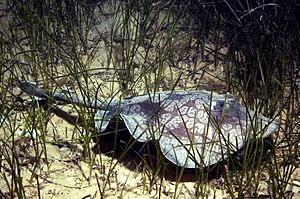Spotted stingaree facts for kids
Quick facts for kids Spotted stingaree |
|
|---|---|
 |
|
| Conservation status | |
| Scientific classification | |
| Kingdom: | |
| Phylum: | |
| Class: | |
| Subclass: | |
| Order: | |
| Family: |
Urolophidae
|
| Genus: |
Urolophus
|
| Species: |
U. gigas
|
| Binomial name | |
| Urolophus gigas T. D. Scott, 1954
|
|
The spotted stingaree (Urolophus gigas) is a type of stingray. It lives in the shallow waters off southern Australia. These rays like to hang out near rocky reefs and in seagrass beds. You can easily spot them by their almost round, dark bodies. They have cool patterns of white or cream spots.
Spotted stingarees are a bit shy, especially during the day. They mostly eat crustaceans, like crabs and shrimp. Female stingarees give birth to live young. They can have up to 13 babies at a time. The mother provides special "uterine milk" to her pups while they grow inside her. This stingray is not usually aggressive towards people. The International Union for Conservation of Nature (IUCN) says it's a species of "Least Concern." This means it's not currently in danger. This is partly because not much fishing happens where they live. Also, their rocky homes protect them from fishing nets.
Contents
About the Spotted Stingaree
The first spotted stingaree ever studied was found near Port Noarlunga in South Australia. A scientist named Trevor Scott described it in 1954. The word gigas in its scientific name comes from Greek. It means "giant."
There are slight differences in color between the stingarees found in the east and west. Some scientists even think the western form might be a separate species.
Where They Live
Spotted stingarees are found along the southern coast of Australia. Their range goes from Albany, Western Australia to Lakes Entrance, Victoria. This includes Bass Strait and the northern coast of Tasmania. They are not super common, and they don't gather in large groups.
These rays live on the ocean floor. You can find them from the shallowest parts of the coast down to about 50 m (160 ft) deep. They are most often seen in seagrass beds and rocky reefs. They have also been found in estuaries, which are places where rivers meet the sea.
What They Look Like
The body of a spotted stingaree is shaped like an oval, a bit longer than it is wide. Young stingarees have a more circular body. Their snout is soft and usually smooth. They have tiny eyes, followed by larger, comma-shaped holes called spiracles. These help them breathe.
Between their nostrils, they have a flap of skin that looks like a skirt. Inside their small mouth, they have 9 to 12 small bumps called papillae. Their teeth are tiny and have oval bases. They have five pairs of short gill slits. Their pelvic fins are small and round.
Their tail is about 76-80% as long as their body. It's quite thick and has no skin folds on the sides. On top of the tail, there's a stinging spine with jagged edges. Just in front of this spine, there's a noticeable dorsal fin. The caudal fin (tail fin) is short, deep, and shaped like a spear. Their skin is completely smooth.
The top of their body is dark brown to black. It gets lighter towards the edges. Sometimes, they have scattered dark dots. They also have 2-3 rows of small whitish spots along the edge of their body. These spots can sometimes go onto their tail. They also have larger pale spots grouped together on the middle of their back. Areas around their eyes and two patches at the back of their body usually don't have spots. Young stingarees might have a light stripe on their tail. Some adults have light spots on their tail. The dorsal and caudal fins are dark brown or black with whitish edges.
Their underside is white or almost white. Most of them have dark blotches and wide bands along the sides of their body. Sometimes, their color pattern is very faint. These stingarees can grow up to 80 cm (31 in) long.
Life and Habits
During the day, the spotted stingaree often hides. It might bury itself in the sand or hide among seagrass or rocks. They mainly eat crustaceans.
Like other stingrays, the females give birth to live young. The growing embryos get food from a special "uterine milk" provided by the mother. Females can have up to 13 babies in one litter. Males become old enough to reproduce when they are about 42 cm (17 in) long. Females reach this stage when they are about 46 cm (18 in) long.
Spotted Stingarees and Humans
The spotted stingaree is not as aggressive as some other stingray types if people bother them. There isn't much fishing in most of the areas where these stingarees live. Also, because they prefer rocky habitats, they are mostly safe from large fishing nets called bottom trawls.
Sometimes, they are accidentally caught by fishing boats in the Southern and Eastern Scalefish and Shark Fishery (SESSF). However, this doesn't happen very often. They could potentially be affected by changes to their habitat or by recreational fishing. But because they are not greatly threatened by human activities, the International Union for Conservation of Nature (IUCN) has listed the spotted stingaree as "Least Concern."
This species lives in several small Marine Protected Areas (MPAs). These are special areas designed to protect ocean life. The stingaree could also benefit from a plan made in 2004 to help conserve sharks in Australia.


